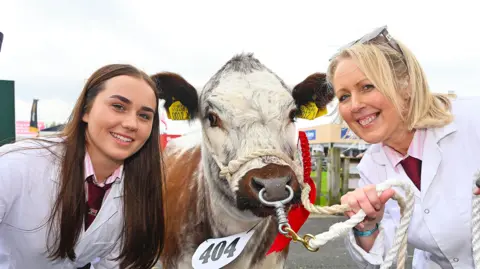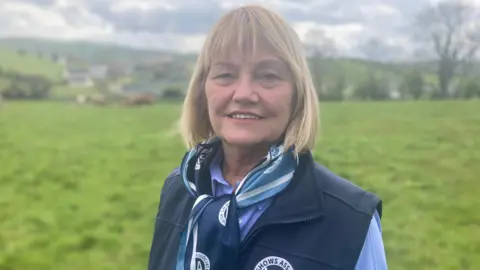Rising costs threaten future of farming shows
 BBC
BBCWith more than 100,000 visitors each year, the Balmoral Show is a success in anyone's books.
But for the season of agricultural shows that it kicks off, things may not be as secure.
"All shows are going to be under pressure," is the prognosis of Brian Hunter who chairs the organising committee for the Saintfield Agricultural Show.
Their plans are well under way for this year's event in June, but their counterparts in Fermanagh are in a different position.
Organisers have effectively cancelled the Fermanagh County Show this year, after moving to a new venue in 2023 with the ambition of expanding.
They have cited "escalating costs of service provision... an increased demand for risk assessments (and) the cost of training for volunteer stewards" as the main reasons.
The disease status of herds in Fermanagh has also made breeders cautious about exhibiting quality livestock at agricultural shows.
 Pacemaker
PacemakerCosts rise each year
On the other side of Northern Ireland, Brian Hunter can sympathise.
"The challenge is getting heavier every year.
"Economic pressure comes on, costs rise, people who are coming to the show are more economically under pressure and have to think twice about spending money to come to a show.
"And our costs rise each year.
"Sponsorships are harder and harder to find, trying to persuade people to sponsor year on year - it's just hard work."
Most shows hold reserves of cash, but increasing costs have squeezed them and raising entrance prices is a risky option during a cost-of-living crisis.
The Irish Shows Association is the umbrella body for agricultural shows on the island of Ireland.
Northern chair Marjory Blackburn has described the challenge of putting on a show as "not easy", with a hunt for additional sponsors every year.
"We all have to look at what we're spending on and what we're hoping to achieve and what we can do different at the shows.
"You're always looking for new sponsors, new activities to have at your show to bring a wider set of community people into the show.
"It's all about that connection."

The challenge may be made greater by funding issues.
In the Republic of Ireland, each show receives a grant of €6,000-11,000 (£5,160-£9,460) depending on their size.
In Northern Ireland, a bounce-back scheme helped shows post-Covid, but there is no continuing additional government support for agricultural shows.
The Department of Agriculture, Environment and Rural Affairs (Daera) provides sponsorship from a pot of £5,000 shared across all shows.
An Independent Resilience Review of Shows was ordered in 2022 by the former Daera Minister Edwin Poots.
It made eight recommendations including a new multi-year programme of funding and support for agricultural shows.
It also recommended increased collaboration and an economic impact assessment to provide evidence "to underpin ongoing support".
And it outlined four options of providing core funding, a two-tier model, a single innovation fund or continuing as things are.
In a statement, Daera said funding for agricultural shows will be considered as part of the 2024/25 budget process.
And it added that statutory obligations and contractual commitments will require funding first, before it can be determined if there is scope to fund discretionary expenditure such as support for agricultural shows.
'Fermanagh Show may not be the only one to go'
"If we had a wet year, we would be wiped out in terms of finance to run a show for the following year," said Mr Hunter.
"It's local events, raising money in the economy for local producers and supporting local hostelries in terms of judges coming and staying overnight and all that, so it's making money in the community.
"I think they (Stormont) should be looking at small grants to operate it as a tourist event similar to the grants that are given to the likes of the North West [200].
"At this stage you're totally relying on local firms to sponsor us to get any funds at all."
The Fermanagh County Show committee is planning to hold a children's art exhibition in August and to judge some livestock on farms, with an autumn prizegiving event.
But for Mr Hunter, what has happened there is "the thin end of the wedge" with more to follow.
"If you're very lucky you'll break even, and if you have a bad year, you're down three, four, five thousand pounds just so quickly.
"It’s the start of it and Fermanagh may not be the only one to go in the next few years."
